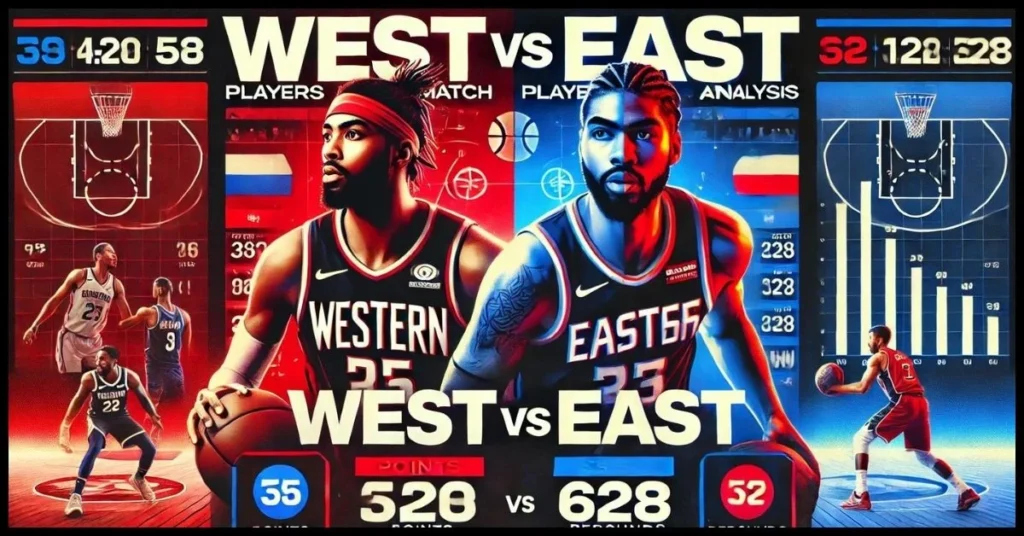In the world of sports, especially in major league games, the rivalry between the West and East has always been a significant talking point. The “West vs. East match player stats” provide an in-depth understanding of how players from both sides compare in terms of performance, skill, and impact on the game. This article delves into the key statistics, trends, and insights that highlight the differences and similarities between players from these two regions.

Understanding the Historical Context of West vs. East Matches
The rivalry between the Western and Eastern conferences dates back to the inception of major sports leagues in the United States. Whether it’s the NBA, NFL, or NHL, the competition between these two sides has always been fierce. Over the years, the “West vs. East match player stats” have shown how players from different regions bring unique strengths and styles to the game.
Historically, the Western Conference has been known for its fast-paced, high-scoring games, often dominated by players with exceptional athleticism. On the other hand, the Eastern Conference is traditionally recognized for its strong defensive strategies and players who excel in teamwork and tactical play. These differences have shaped the stats we see today.
Key Statistics in West vs. East Matches
Scoring Averages
One of the most critical aspects of “West vs. East match player stats” is the scoring averages. In recent years, players from the Western Conference have often outscored their Eastern counterparts. For instance, in the NBA, top scorers like Stephen Curry and LeBron James (during his time with the Lakers) have consistently led the Western Conference in points per game.
However, this doesn’t overshadow the Eastern Conference, where players like Giannis Antetokounmpo and Kevin Durant have also posted impressive scoring numbers. The difference often lies in the style of play, with the West favoring a more open, run-and-gun style, leading to higher individual scoring averages.
Defensive Stats
Defense is where the Eastern Conference often shines in “West vs. East match player stats.” Teams from the East are known for their tough, grind-it-out defense, which is reflected in player stats like blocks, steals, and defensive rebounds. Players like Joel Embiid and Bam Adebayo have anchored their teams’ defenses, making it difficult for Western Conference stars to dominate.
In contrast, while the Western Conference also boasts excellent defenders, the overall defensive stats often favor the East. This is due to the East’s strategic focus on slowing down the game and forcing their opponents into tough, contested shots.
Assists and Playmaking
When it comes to playmaking, the West vs. East match player stats reveal interesting trends. Western Conference players are often seen as more dynamic in creating scoring opportunities, not just for themselves but also for their teammates. Players like Nikola Jokić, who has led the league in assists from the center position, exemplify the West’s focus on versatile playmaking.
Meanwhile, the Eastern Conference also has its share of elite playmakers, such as James Harden and Trae Young. However, the style of play in the East often emphasizes ball movement within a structured offense, leading to slightly lower individual assist numbers but higher team assists.
Impact of Coaching Styles on Player Stats
The differences in “West vs. East match player stats” can also be attributed to the coaching philosophies prevalent in each conference. Coaches in the West are often more willing to experiment with offensive schemes, which can lead to inflated offensive stats for players. In contrast, Eastern Conference coaches typically emphasize discipline, defense, and team-oriented play, which affects how player stats distribute.
Player Development and Regional Differences
Another factor contributing to the “West vs. East match player stats” is the regional development programs and talent pipelines. The Western Conference develops physically gifted and versatile players, often leading to higher individual stats in scoring and rebounding.
The Eastern Conference, on the other hand, produces players who excel in specific roles within a team system. This often results in more balanced stats across the board, with no single player dominating in multiple categories but rather contributing significantly to the team’s overall success.
FAQs
Q: Which conference has better players, West or East?
A: While both conferences have elite players, many perceive the Western Conference as having more depth in terms of star power. However, the Eastern Conference’s strong defensive play and tactical discipline make it difficult to compare the two directly.
Q: How do “West vs. East match player stats” influence All-Star selections?
A: Player stats heavily influence All-Star selections, with top performers from both conferences earning spots. Historically, selectors chose more Western Conference players due to higher scoring averages, but Eastern Conference players represent equally in defensive stats and overall impact.
Q: Do West vs. East match player stats affect playoff outcomes?
A: Yes, these stats can significantly influence playoff outcomes. Teams with players who perform well in West vs. East matchups often carry that momentum into the playoffs, where every game is critical.
Q: How do injuries impact West vs. East match player stats?
A: Injuries can have a significant impact, as losing a key player can skew the stats in favor of the other conference. The depth of the roster and the ability to adapt to injuries are crucial factors in maintaining competitive stats.
Q: Are there any trends in recent West vs East match player stats?
A: In recent years, there has been a trend of increasing parity between the two conferences. Although the West historically dominated, the East has caught up, resulting in more evenly matched games and balanced player stats.
Conclusion
The ongoing rivalry between the Western and Eastern Conferences offers a fascinating glimpse into the diverse styles and strategies that define modern sports. By examining the “West vs. East match players stats,” we gain valuable insights into how players from these regions contribute to their teams and the game as a whole. While the Western Conference may lead in certain offensive metrics, the Eastern Conference excels in defense and teamwork, creating a balanced and competitive landscape. As both conferences continue to evolve, these statistics will undoubtedly play a crucial role in shaping the future of the sport.
- Minecraft (2009) Game Icons Banners A Guide to Customization and Creativity - 19 December 2024
- Understanding QXEFV A Comprehensive Guide - 29 October 2024
- Discover Shopping Excellence with Shopyistan.pk – Your Ultimate Destination for Quality and Convenience - 29 October 2024
